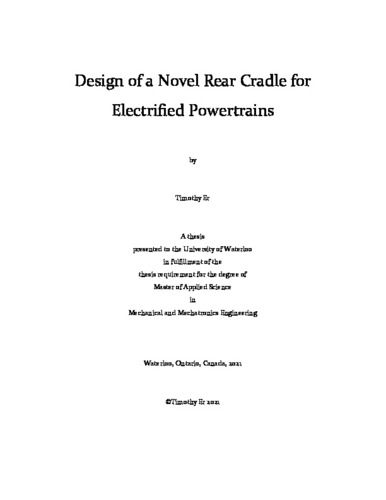| dc.description.abstract | With the ever-increasing, stringent requirements of fuel economy, automotive manufacturers have cited reduction of vehicle weight as one of the most effective methods of decreasing fuel consumption and emissions. Due to the abundance of traditional combustion-engine vehicles on the road, it is not uncommon for independent research groups or shops to convert these vehicles to hybrid, or full electric. In doing so, major changes to key structural aspects of the vehicle are required. However, it is far too often found that changes are made without proper analysis and design of the component. As such, this thesis provides an outline on the processes and methods used to develop a prototype structural component; in this case a custom rear cradle was used as an example, which was redesigned to house an electric motor drive unit in an existing production vehicle.
Firstly, requirements such as structural strength, stiffness, and manufacturability were devised. In considering all these requirements, 6061-T6 aluminum was set as the new material for this component, given its high specific strength and stiffness, as well as ease of manufacturability and cost. Fatigue analysis was conducted to develop new structural requirements for this component, given its differing material properties from the previous design being made from steel.
Next, topology optimization was conducted to gain an idea of an optimized, lightweight structure that met requirements. Structural analysis utilizing beam theory allowed for rapid iteration of tube diameters and wall thicknesses, this was translated to analysis of full geometry once requirements were met.
All in all, the final design yielded a lighter component, while maintaining structural integrity. The new cradle design represents a weight savings of 57% over the 2019 cradle, while satisfying all the requirements set. It is expected that further weight reduction is possible, given future development in fatigue analysis and certain design aspects of the cradle. As such, the processes and methods outlined in this thesis can be applied to other structural components of similar nature for prototype vehicles. | en |

